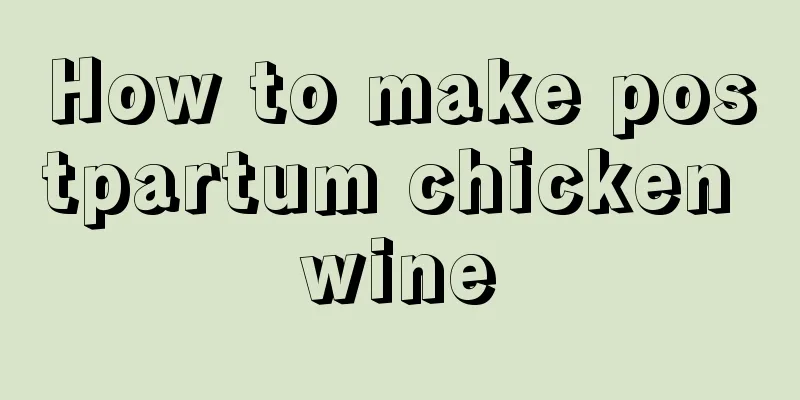Six-month-old baby's first complementary food

|
After six months, babies can start eating complementary foods. However, adding complementary foods needs to be regular because the baby is young and has an imperfect digestive system. Therefore, you should be careful to avoid eating too much complementary food, and breast milk should be the main drink. Special attention should be paid when adding complementary food to a six-month-old baby for the first time, as it often affects the baby's body's digestive function. What is the first complementary food for a six-month-old baby like? From less to more: For example, the amount of egg yolk ranges from 1/4 to 1/2 to 1 egg yolk. From thin to thick: Such as rice soup - rice paste - thick porridge - soft rice From fine to coarse: Such as vegetable juice - vegetable puree - chopped vegetable - vegetable leaves - vegetable stems From plant-based foods to animal-based foods: Such as cereals - vegetables - fruits - eggs - meat Tip: For meat, you can follow the order: white meat → red meat → deep-sea fish. Generally, it can be divided into animal liver (6 months+) → freshwater fish, poultry and livestock meat (7-8 months+) → seafood fish and shrimp (12 months+) 4-6 months old baby: What to eat: (1) Breast milk or formula milk, plus the following foods (2) Semi-liquid food (such as rice soup, vegetable juice or fruit juice) and mushy food (rice paste, vegetable puree or fruit puree) Feeding amount: (1) Start with 1 teaspoon of pureed food. You can use 4-5 teaspoons of breast milk or formula to mix cereal (very thin). (2) Gradually increase the amount of pureed food to two meals a day. If it is grains, gradually thicken it. (1 teaspoon = 5ml, 1 tablespoon = 15ml) Note: If your baby won't eat the first time, try again several times over the next few days. 6-8 months old baby: What to eat: (1) Breast milk or formula milk, plus the following foods (2) Fruit puree (banana, pear, apple, peach) (3) Vegetable puree (cooked carrots, pumpkin, white radish) (4) Puree cooked meat (chicken, pork, beef) (5) Iron-fortified cereals (iron-fortified rice flour) Feeding amount: (1) 1 teaspoon of fruit puree, gradually increase to 1/4 or 1/2 cup, feed 2-3 times a day. (2) 1 teaspoon of vegetable puree, gradually increase to 1/4 or 1/2 cup, and feed it 2-3 times a day. (3) 3 to 9 tablespoons of rice cereal, fed 2 to 3 times a day. (1 teaspoon = 5ml, 1 tablespoon = 15ml, 1 cup = 240ml) Note: Add one new food at a time for at least 3 days to determine whether your baby will be allergic to it. 8-10 months old baby: What to eat: (1) Breast milk or formula milk, plus the following foods (2) Mashed vegetables and fruits (bananas, peaches, pears, avocados, cooked carrots, pumpkin, potatoes, sweet potatoes) (3) Finger foods (small pieces of ripe banana; hard-boiled eggs; cooked yellow squash slices, peas, potatoes; spiral pasta; chewing crackers) (4) Small amounts of protein foods (eggs; cooked meat, poultry, and boneless fish) (6) Iron-fortified cereals (barley, wheat, oats, mixed cereals) Feeding amount: (2) 1/4 to 1/2 cup of iron-fortified cereal (3) 1/4 to 1/2 cup fruit puree (4) 1/4 to 1/2 cup vegetable puree (5) 1/8 to 1/4 cup of protein food (1 cup = 240 ml) 10-12 months old baby: What to eat: (1) Breast milk or formula milk, plus the following foods (2) Fruit cut into small pieces, strips or mashed (3) Bite-sized soft-cooked vegetables (peas, carrots) (4) Mixed food (eating tomatoes and noodles together) (5) Protein foods (eggs; pureed or ground meat, poultry, and fish; tofu; cooked and mashed beans) (6) Finger foods (lightly toasted bread or bagels, small pieces of peeled bananas; scrambled eggs; yellow squash, peas, potatoes; spiral pasta; chewing crackers) (7) Iron-fortified cereals (barley, wheat, oats, mixed cereals) Feeding amount: (1) 1/4 to 1/2 cup of iron-fortified cereal (2) 1/4 to 1/2 cup of fruit (3) 1/4 to 1/2 cup of vegetables (4) 1/8 to 1/4 cup of mixed food (5) 1/8 to 1/4 cup of protein food (1 cup = 240 ml) 12-24 months old baby: What to eat: (1) Yogurt (children under 2 should avoid drinking fresh milk) (2) Eat the same food as your family, mashing or cutting the food into bite-sized pieces (3) Iron-fortified cereals (oats, barley, wheat, mixed grains) (4) Other grains (whole-wheat bread, pasta, rice) (5) Fruits: watermelon, papaya, apricot, grapefruit (6) Vegetables: broccoli and cauliflower leaves cooked until soft (7) Protein foods (eggs; cuts or minced meat/poultry; boneless fish; tofu; beans; smooth peanut butter) (8) Citrus and citrus juices |
<<: How many months does it take for babies to start adding complementary foods?
>>: Six to seven months baby food
Recommend
How to make egg avocado burger
Take time to cook a delicious and nutritious home...
How to make shrimp pot stickers
People who can cook are actually very attractive,...
How to make Tom Yum Lychee and Salmon Soup
People often complain about being stressed, havin...
There are so many kinds of fried dough stick soup. Do you know how to make it?
Fried dough sticks soup is a very popular soup in...
How to make crispy melon meat sauce
Does your busy daily work make you feel tired? Ar...
How to make black sesame sweet potato pancake
For a single person, if a person of the opposite ...
King Oyster Mushroom and Abalone Sauce
King oyster mushroom and abalone sauce is a commo...
How to make green rose buns
People who are in good health are those who know ...
Mango Yogurt Recipe
Many times, we envy others for having a relative ...
How to make the new version of three fresh delicacies
For everyone, when they reach a certain age, they...
How to make bell pepper bacon pancake rings
After a busy day, coming home and cooking a delic...
How to make leek bean sprouts
Does your busy daily work make you feel tired? Ar...
How to make fish paste stuffed cucumber
If you are unmarried, are you wandering around al...
Pan-fried sweet and sour hairtail
In life, there are many women who particularly li...
How to make shredded radish with pepper
You often have friends coming to your house, but ...









